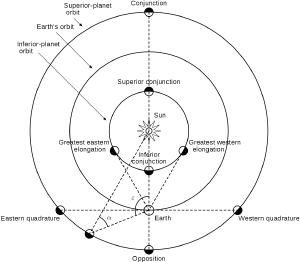Blog
The Evening Star
18 March 2020
If you are among the millions staying home with their children at the moment, you might be wondering about some activity (any activity) to keep the younglings a bit occupied. One possibility would be to do a bit of naked-eye astronomy. You could start by looking for Venus in the evening sky.
Venus orbits the Sun at a distance closer than Earth, which means we always see the planet relatively close to the Sun. You will never see Venus high overhead in the middle of the night because the Earth is never between Venus and the Sun. Because of this, when Venus is visible it is typically seen in the western sky just after sunset, or in the eastern sky just before sunrise. It tends to be very bright during these times, which is why it’s often called the evening or morning star.
 Wikipedia user Wmheric, CC BY-SA 3.0
Wikipedia user Wmheric, CC BY-SA 3.0Currently, Venus is in the evening sky. If you look to the west after sunset, it will look like a very bright star. But unlike stars, it won’t twinkle. It should be very easy to spot for two reasons. The first is that it is close to the Spring Equinox. This means the ecliptic (the orbital plane of the solar system) is oriented away from the horizon in the northern hemisphere. The second is that Venus is approaching greatest elongation.
Greatest elongation occurs when Venus reaches its greatest angle from the Sun. For Venus that’s about 46°, and it occurs this year on March 24. If you have a pair of binoculars or a small telescope, you can also see Venus as a crescent shape. When Venus reaches greatest elongation, it will be a half-crescent, and then it will become a thinner crescent as its angle from the Sun decreases.
Galileo was the first to document the phases of Venus. From this, he was able to show that Venus truly orbited the Sun, which helped confirm the Sun-centered solar system.
Venus will be easy to observe for about a month, even in areas with lots of light pollution. So why not have your kids document their observations with notes and sketches each evening. As Spring and Summer roll around, there will be other interesting things to look for.